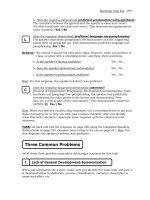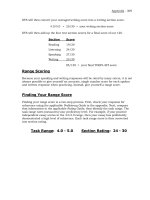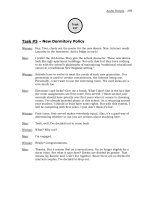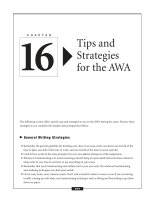Nicholas investing in hedge fund; strategies for the new marketplace (1999)
Bạn đang xem bản rút gọn của tài liệu. Xem và tải ngay bản đầy đủ của tài liệu tại đây (1.3 MB, 319 trang )
Praise for
INVESTING IN HEDGE FUNDS:
STRATEGIES FOR THE NEW MARKETPLACE
by Joseph G. Nicholas
“This book tells all. It explains how [hedge funds] work. THIS
IS A SERIOUS AND IMPORTANT BOOK ON THE SUBJECT AND
MUST BE READ BY ANY SERIOUS INVESTOR.”
TradersWorld Magazine
“N I C H O L A S H A S D O N E A N I N V A L U A B L E S E R V I C E in laying
out exactly how hedge funds work, who runs them, how they
incorporate, their benefits and risks, and how to go about
selecting one.”
the street.com
“For investors who want to learn about hedge funds from
A-to-Z, T H I S B O O K I S A M U S T - R E A D . For those who think
they already know about the approximately 4,500 hedge
funds with close to $300 billion in assets, R E A D T H I S B O O K
A N D L E A R N W H A T Y O U D O N ’ T K N O W .”
peter morgan kash
Senior Managing Director, Paramount Capital Asset
Management
Board Member, Hedge Fund Association
Adjunct Professor, Wharton School of Business
“In light of the dramatic increase of investments in hedge
funds, the recent media attention, and the widespread
need to better understand these complex strategies, J O E
NICHOLAS HAS CREATED A KEY INVESTOR GUIDE TO HEDGE
including the unique and valuable perspective of
having top hedge fund managers describe what they do in
their own words.”
timothy j. leach
Chief Investment Officer
Wells Fargo Private Client Services
FUNDS,
“I have yet to find a book W H I C H D O E S S U C H A G O O D J O B
of demystifying an area which has been kept deliberately
opaque (with good reason) by its players.”
AIMA (Alternative Investment Management
Association) Newsletter
“Joe Nicholas has written the definitive book on what one
needs to know to invest in hedge funds. I T I S A C L E A R , C O N C I S E A N A L Y S I S of an area that is too often misunderstood.
IT SHOULD BE REQUIRED READING FOR ANYONE CONSIDERI N G T H I S T Y P E O F A L T E R N A T I V E I N V E S T M E N T .”
cappy r. mcgarr
President
McGarr Capital Holdings, LLC
“Investing in Hedge Funds is the first comprehensive study of
what hedge funds are and how they work. T H I S I S A N E S S E N TIAL BOOK FOR ALL INVESTORS CURIOUS ABOUT ALTERNATIVE INVESTMENT STRATEGIES.
Joseph Nicholas details the
range of investment strategies pursued by hedge fund managers and writes in a clear, lucid style. I HIGHLY RECOMMEND
THIS BOOK TO ACADEMICS AND PROFESSIONALS WHO WANT
TO LEARN ABOUT HEDGE FUNDS .”
professor william n. goetzmann
Director, International Center for Finance
Yale School of Management
“ I N V E S T I N G I N H E D G E F U N D S I S A G R E A T P R I M E R for
anyone looking at our industry. W E L L - R E S E A R C H E D A N D
C L E A R L Y W R I T T E N , this comprehensive guide should help
both novices and experienced hedge fund investors gain a
better understanding of how funds generate their returns
and assist them in determining if hedge funds are right
for them.”
ron pollack
Chief Investment Officer
Monitor Fund Advisors, LLC
This page intentionally left blank
INVESTING IN
Hedge
FUNDS
ALSO BY JOSEPH G. NICHOLAS
Hedge Fund of Funds Investing:
New Strategies for the Hedge Fund Marketplace
by Joseph G. Nicholas
Market-Neutral Investing:
Long/Short Hedge Fund Strategies
by Joseph G. Nicholas
Also available from
BLOOMBERG PRESS
Investing in REITs:
Real Estate Investment Trusts
Revised and Updated Edition
by Ralph L. Block
Wall Street Secrets for Tax-Efficient Investing:
From Tax Pain to Investment Gain
by Robert N. Gordon
with Jan M. Rosen
The Money-Making Guide to Bonds:
Straightforward Strategies for Picking
the Right Bonds and Bond Funds
by Hildy Richelson and Stan Richelson
A complete list of our titles is available at
www.bloomberg.com/books
ATTENTION CORPORATIONS
this book is available for bulk purchase at special discount.
Special editions or chapter reprints can also be customized to
specifications. For information, please e-mail Bloomberg
Press, p r e s s @ b l o o m b e r g . c o m Attention: Director of Special
Sales, or phone 609-750-5070.
INVESTING IN
Hedge
FUNDS
Strategies for the New Marketplace
J O S E P H G. N I C H O L A S
B L O O M B E R G P R E S S
P
R
I
N
C
E
T
O
N
© 1999 by Joseph G. Nicholas. All rights reserved. Protected under the
Berne Convention. Printed in the United States of America. No part of this
book may be reproduced, stored in a retrieval system, or transmitted, in any
form or by any means, electronic, mechanical, photocopying, recording,
or otherwise, without the prior written permission of the publisher except
in the case of brief quotations embodied in critical articles and reviews. For
information, please write: Permissions Department, Bloomberg Press, 100
Business Park Drive, P.O. Box 888, Princeton, NJ 08542-0888 U.S.A.
BLOOMBERG, BLOOMBERG NEWS, BLOOMBERG FINANCIAL
MARKETS, OPEN BLOOMBERG, THE BLOOMBERG FORUM, COMPANY CONNECTION, COMPANY CONNEX, BLOOMBERG PRESS,
BLOOMBERG PROFESSIONAL LIBRARY, BLOOMBERG PERSONAL
BOOKSHELF, and BLOOMBERG SMALL BUSINESS are trademarks and
service marks of Bloomberg L.P. All rights reserved.
This publication contains the author’s opinions and is designed to provide
accurate and authoritative information. It is sold with the understanding
that the author, publisher, and Bloomberg L.P. are not engaged in rendering legal, accounting, investment-planning, or other professional advice.
The reader should seek the services of a qualified professional for such
advice; the author, publisher, and Bloomberg L.P. cannot be held responsible for any loss incurred as a result of specific investments or planning
decisions made by the reader.
All charts, graphs, and illustrations contained herein were created from
data provided by Hedge Fund Research, Inc. All rights reserved. Reprint
by permission only.
Nicholas, Joseph G., 1959–
Investing in hedge funds: strategies for the new marketplace /
Joseph G. Nicholas
p. cm. -- (Bloomberg personal bookshelf)
Includes bibliographical references and index.
ISBN 1-57660-060-2
1. Hedge Funds--United States. I. Title. II. Title: Hedge funds.
III. Series.
HG4930.N53 1999
332.64’5--dc21
98-45960
CIP
Book design by Don Morris Design
SOURCE: BPTHESANS-PLAIN 5/12 SMALLCAPS TRACK 50
First edition published 1999
1 3 5 7 9 10 8 6 4 2
To my parents
Diana and George Nicholas
I N T R O D U C T I O N
Why a book about Hedge Funds? Why Now? 1
P A R T
I
Keys to Understanding
C H A P T E R
20
1
What Is a Hedge Fund?
C H A P T E R
22
2
The Hedge Fund Investment Structure
P A R T
I I
Investing with Knowledge
C H A P T E R
3
Hedge Fund Strategies
C H A P T E R
60
4
Fixed-Income Arbitrage
C H A P T E R
104
6
Convertible Arbitrage
C H A P T E R
118
7
Merger (Risk) Arbitrage
C H A P T E R
132
8
Distressed Securities
C H A P T E R
88
5
Equity Market-Neutral
C H A P T E R
58
142
9
Event-Driven Strategies
156
36
C H A P T E R
1 0
Macro Investing
C H A P T E R
1 1
Sector Funds
C H A P T E R
178
1 2
Equity Hedge
C H A P T E R
168
192
1 3
Emerging Markets
C H A P T E R
1 4
Short Selling
P A R T
206
220
I I I
Making an Investment
C H A P T E R
230
1 5
Investing in Hedge Funds
C H A P T E R
232
1 6
After the Initial Allocation
252
E P I L O G U E
The Future of Hedge Funds
264
A P P E N D I C E S
A. Calculation Methodology 2 7 4
B. Resources for Investors 2 7 6
C. Hedge Fund Research Performance Indices 2 7 8
G L O S S A R Y
286
N O T E S
291
I N D E X
293
This page intentionally left blank
ACKNOWLEDGMENTS
SOURCE: BPTHESANS-PLAIN 5/12 SMALLCAPS TRACK 50
i thank the following:
For his work on all aspects of the book: Ben Borton.
For their advice, wisdom, and assistance in developing
the investment methods and systems discussed in this
book, as well as their comments, Mikhail Kimbarovsky and
Lori Thompson.
For their insightful help and comments, in good times
and bad, on the various strategy chapters we would like to
thank the following managers and their staffs: Herb Adler,
Jack Barry, Robert Butman, Michelle Day-Gillette and
Steve Holtzman, Kate Doyle, Ed Finn and Dan Sido, Ian
Hague, Brian Higgins, Randy Jacobis and Paul Upcraft,
Dale Jacobs, Russ Kamp, Peter Kash, George Kellner, Dan
Knight, Chris Luck, Cappy McGarr, Thomas Noddings
and Jerry Van Fleet, Ron Pollack, Paul Siegal, Tim Stack,
Ernest Werlin, and Rich Whitman.
For their help building the Hedge Fund Research database: all present and former staff at Hedge Fund Research.
For his useful suggestions and assistance in editing, Robert
M. Pine. For help with graphics: Mike Miranda. For assistance with manuscript preparation, Michele Anabile. For
her patience and encouragement: Jacqueline Murphy at
Bloomberg Press.
This page intentionally left blank
INTRODUCTION
I N V E S T I N G
I N
H E D G E
F U N D S
F
rom january 1990 to March
1998, the hedge fund industry’s assets grew twenty
fold, from $20 billion to over $400 billion (see Table 1
on page 4) 1 . Over the same period, the number of
hedge funds increased from 200 to over 3,000 (see
Table 2 on page 5). Many of us have read periodic
reports in the press about hedge funds that generate
outsized returns and losses and influence global
markets. Most individuals who are familiar with the
investment industry know a hedge fund manager or
have a friend that does. Some of the biggest names in
investing are or were hedge fund managers: George
Soros, Julian Robertson, Michael Steinhardt.
Increasingly the top minds in finance have left
prestigious positions with more traditional funds to
start hedge funds. For example, John Meriwether,
former Salomon Inc. vice chairman and arbitrage
specialist, formed Long-Term Capital Management
SOURCE: BPTHESANS-PLAIN 5/12 SMALLCAPS TRACK 50
2
I N T R O D U C T I O N
Inc. in 1994. Jeff Vinik, who traded Magellan, one of
the world’s most famous mutual funds, left it to start
his own hedge fund in 1996. Jon Jacobson managed
part of Harvard’s endowment for the better part of
the 1990s. When he announced that he was leaving
to start a hedge fund, Harvard responded by allocating
$500 million to the fund. A greater level of control,
the freedom to use almost any financial tool imagSOURCE: BPTHESANS-PLAIN 5/12 SMALLCAPS TRACK 50
inable, and the enormous amount of money that can
be made under an incentive-based fee structure are
some of the reasons why top talent has made its way
to hedge funds. The growth of the industry is obvious.
This introduction provides an explanation.
Despite their growing presence in world financial
and investment circles, hedge funds are still enveloped
in a veil of mystery. Questions abound. What are hedge
funds and who runs them? What kind of investment
opportunities do they offer and why should I consider
3
4
I N V E S T I N G
1
I N
H E D G E
F U N D S
HEDGE FUND INDUSTRY ASSET GROWTH
400
In Billions
350
300
250
200
150
100
50
0
1990
1991
1992
1993
1994
1995
1996
1997
Data include both domestic and offshore funds.
What kind of information do I need and where can I
get it? How do I evaluate a hedge fund and how do I
invest? What should I look for and what should I avoid?
Whether one ultimately decides to invest in hedge
funds and the strategies they pursue, it is important
to be informed in order to make an intelligent
investment decision. The purpose of this book is to
address these questions, share some practical insight
into the industry, and provide the investor a starting
SOURCE: BPTHESANS-PLAIN 5/12 SMALLCAPS TRACK 50
them? What are the benefits and what are the risks?
5
I N T R O D U C T I O N
2
HEDGE FUND INDUSTRY NUMBER OF FUNDS
3,000
2,500
2,000
1,500
1,000
500
0
1990
1991
1992
1993
1994
1995
1996
1997
Data include both domestic and offshore funds.
SOURCE: BPTHESANS-PLAIN 5/12 SMALLCAPS TRACK 50
point for making hedge fund investment decisions.
Money managers who distinguish themselves do so
not by acting on where profit was generated in the
past, but where profit will be generated in the future.
Those who correctly anticipate profit potential search
in overlooked, complicated, or misunderstood places
and employ the tools and techniques necessary to
realize them. For the vast majority of investors, the
traditional stock and bond investments pursued by
individuals, mutual funds, and investment advisory
I N V E S T I N G
I N
H E D G E
F U N D S
firms represent where the investment community is
now. But regulation and tradition restrict the
investment approaches they employ in ways that limit
the investment strategies and opportunities they can
pursue. A private investment industry has advanced
onto the global investment scene to profit from
nontraditional opportunities. Some of the world’s
most sophisticated investors fund the industry, and
their money is managed by a group of talented and
savvy money managers who pursue a broad spectrum
of alternative investment strategies. The assets are
pooled and managed in private investment structures
called hedge funds.
Assets are flowing to hedge funds at an increasing
rate because institutions and individuals alike see
hedge funds as an integral part of their overall
investment approach. By providing exposures that
investors may not already have, hedge funds allow
these investors to further diversify their investment
portfolios, protect against risks inherent in traditional
stock market approaches, and realize excess returns.
The specialized strategies that hedge fund managers
SOURCE: BPTHESANS-PLAIN 5/12 SMALLCAPS TRACK 50
6
I N T R O D U C T I O N
employ provide access to markets around the globe.
But, they do not all pursue the same investment
approach or provide the same exposures.
Some provide lower risk alternatives to traditional
investments; others, through the use of leverage, take
outsized risks in search of large gains. They may
specialize in long-term investment approaches,
arbitrage opportunities, or short term trading
strategies. Some make profits as markets rise and some
as markets fall. Some provide protection against
market declines or neutralize certain market risks.
Others magnify the exposure to various markets.
SOURCE: BPTHESANS-PLAIN 5/12 SMALLCAPS TRACK 50
Hedge fund managers are entrepreneurs who
establish specialized money management firms.
Expanding global markets provide plenty of areas
where they can mine profits. By harnessing the power
of computers and information technology and
applying their skill and expertise toward identifying
profit opportunities, they provide a method to access
these potential returns. An increasing amount of
information is available at decreasing cost. At the same
time, we are in the midst of a period of global
7
I N V E S T I N G
I N
H E D G E
F U N D S
economic and political change unparalleled in history.
As global markets expand and become increasingly
complex, inefficiencies emerge which create
specialized opportunities for investors. Many hedge
fund strategies are utilized by small specialist shops
that a decade or two ago could not have used them,
because the information required to exploit these
inefficiencies was only available at a high cost that only
the larger brokerage and investment firms could
afford. Real-time information and technological
progress have allowed numerous small money
management operations to use hedge fund strategies
to take advantage of market inefficiencies created by
the changing global economy.
New markets and financial instruments have
emerged and will grow in response to changes driven
by technology and the needs of increasingly
sophisticated global investors. Financial futures were
created in the 1970s, mortgage-backed securities in
the 1980s, and the Russian emerging market was
created in the 1990s. These kinds of changes in
markets and financial instruments create complexities
SOURCE: BPTHESANS-PLAIN 5/12 SMALLCAPS TRACK 50
8
I N T R O D U C T I O N
and pricing uncertainties and thus profit opportunities
that managers employing alternative investment
strategies are well equipped to capitalize on.
Alternative investment strategies allow hedge fund
managers to capitalize on market inefficiencies created
by rapid global economic change in a way that
traditional long-term investment strategies cannot.
Because mutual funds are highly regulated, they have
been restricted in their use of certain instruments and
investment techniques such as leveraging and
derivatives trading. These regulations limit the risk
exposure that a mutual fund can have, but also make
SOURCE: BPTHESANS-PLAIN 5/12 SMALLCAPS TRACK 50
it difficult to outperform the market or to protect
against a general market decline, because their primary
investment tool is the ability to pick good stocks and
bonds. Hedge funds, on the other hand, are not
subject to the same restrictions and can use
nontraditional techniques and instruments to protect
against and profit from such market movements.
Most hedge fund managers are specialized to some
degree and restrict themselves to a particular strategy.
They attract investors by exhibiting a high level of
9
I N V E S T I N G
I N
H E D G E
F U N D S
expertise in that strategy. Today, the majority of hedge
funds are run by managers who pursue high riskadjusted returns for their clients by creating
informational, statistical, or strategic advantages that
allow them to turn market inefficiencies into profits.
It is no secret to the investment community that
market inefficiencies represent profit opportunities.
Markets always seek to become efficient, but they
have—and will continue to have—inefficiencies. In
spite of this, the notions of perfect information, perfect
competition, and theoretical equilibrium still haunt
investors’ thoughts, even though they are concepts
that exist only in the pages of introductory economics
texts. In actuality, market disequilibrium—which
requires a certain level of market inefficiency—is, as
George Soros once said, “inherent in the imperfect
understanding of the participants.” He went on to say
that, “financial markets are inherently unstable, and
the idea of a theoretical equilibrium . . . is itself a
product of our imperfect understanding.” 2 The point
is that as long as it takes time to communicate
information, there will be information gaps, or
SOURCE: BPTHESANS-PLAIN 5/12 SMALLCAPS TRACK 50
10
I N T R O D U C T I O N
inefficiencies, that result in a difference between the
“real” or potential value of an asset and its market
value. Hedge fund managers use informational,
statistical, or strategic advantages to make intelligent,
informed estimates of the real value of assets; take
positions in those assets whose market value differs
from their estimate; hedge out extraneous risk; and
reap the returns when information about the asset
becomes more readily available and the market reacts
accordingly.
A great number of factors have contributed to the
rapid growth of both hedge funds and hedge fund
assets. Here are five that have been the most
important:
1 Opportunity. The continuing expansion of global
markets and the ongoing development of new
markets provides an expanding arena for
investments. As long as economic conditions change
and information flows imperfectly, markets will have
inefficiencies. Markets are always striving to correct
these inefficiencies because they represent profit
opportunities. But while they remain, astute
11









